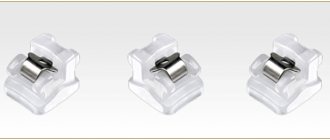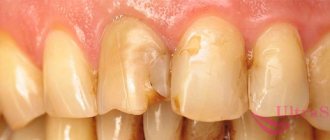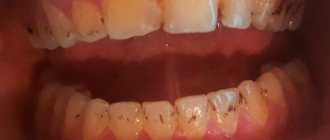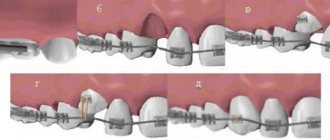Removing the 6th tooth is an operation that is performed quite often. Since sixes have rather deep fissures, their complete cleaning is difficult, which provokes the rapid development of caries. Externally, such damage is difficult to determine. after all, a cavity can form under the enamel. The extraction procedure will allow you to avoid the development of unwanted diseases, and if you follow the dentist’s recommendations, complications during the rehabilitation period.
Why do sixth teeth deteriorate more often than others?
The sixth teeth (first molars according to dental classification) are molars. The rudiments are laid at the 5th month of fetal development, and at the 9th month their mineralization occurs, which continues throughout the first month after the birth of the child. Their final formation with enamel occurs only by the age of 2-3 years. Therefore, the condition of the root and crown depends on the course of pregnancy and childbirth.
Sixes do not erupt in early childhood, since the function of chewing is not yet needed. When they erupt, they do not have predecessors in the form of milk teeth, so they essentially grow from scratch. Of the permanent molars, they begin to erupt first at 5-6 years, so they last longer than others. Frequent diseases, removals and the need for implants are associated with this.
How will the doctor choose which teeth to remove before installing braces?
Removing wisdom teeth before installing braces
Typically, the first “candidate” for removal before installing braces are wisdom teeth or teeth of eight.
The procedure will allow you to obtain free space for the displacement of teeth and increase the effectiveness of treatment with braces, and in addition, eliminate the problem tooth, which very often turns out to be the eighth molar. Eighth molars often grow incorrectly - to the side or downwards, and such growth of the eighth molars can negatively affect the position of other teeth in the row and the bite as a whole. In addition, if these complex teeth never erupted, and treatment with braces has already been carried out, it makes sense to remove the eights as a preventative measure and guarantee that the positive results achieved will be maintained. The removal of eights is also prescribed if these teeth are severely damaged by caries, and it is impossible to provide them with high-quality treatment.
USEFUL TO KNOW: Doctors prefer to preserve healthy and properly growing wisdom teeth, because they fully participate in the formation of bite, chewing processes and can in the future serve as the basis for prosthetics.
Removal of sixth molars or “sixes” before installing braces
These teeth are rarely “sentenced” to be removed before installing braces.
Mainly when they are destroyed and their high-quality and durable restoration is impossible. Also, the doctor may decide to remove the “sixes” if the patient’s teeth are severely crowded, in order to obtain free space in the rows for moving the teeth. There is no need to be afraid that a gap will remain in place of the removed sixth molar. When the teeth move and take an even and beautiful position in the row under the influence of installed braces, this gap will disappear. We will tell you in detail about the timing of closing the gaps of extracted teeth when wearing braces in one of the following sections of the article. Fourth premolars or "quads"
Is it worth getting an implant?
The absence of the sixth tooth threatens:
- displacement of neighboring units;
- advancement of antagonists on the opposite jaw.
Neighboring and antagonist teeth will slowly shift, which threatens to expose the roots, the appearance of wedge-shaped defects at the gum itself, exposure of the neck, which is sensitive to changes in temperature of water and food, and pain. In addition, there will be a change in the bite, since the teeth will be out of place. Therefore, it is necessary to place an implant to maintain healthy teeth and correct bite.
Free consultation on the cost of treatment in our dentistry
Leave a request and the clinic administrator will contact you within 15 minutes!
These teeth are often removed before installing braces to create free space in the rows. The fourth premolars have the shortest and smallest roots, so their removal is carried out quickly and without complications. In addition, these teeth bear less of the chewing load when eating food, and therefore their removal will cause much less harm to the health of patients than extraction of molars.
Removal of fifth premolars or “fives” before installing braces
They are removed before installing braces less often than eights and fours and usually when necessary, in order to obtain space for tooth displacement and preserve a maximum of chewing units.
The fifth premolars are larger in size than the fourth, however, the gap that remains after removing the “five” will not be noticeable either when smiling or when talking. Less commonly, teeth included in the smile zone, incisors, and seventh molars are removed before installing braces. Their removal before installing braces is carried out only if the patient has absolutely healthy wisdom teeth, which will be able to take on the entire load and efficiently perform the chewing function. Guessing which tooth may be removed in your case if you decide to install braces is generally useless. Firstly, this procedure may not be needed at all, and secondly, you need to take into account the malocclusion that needs to be eliminated. Only a specialist, an orthodontist, can assess the condition of your teeth, accurately determine bite defects and decide whether teeth need to be removed before installing braces. And not after one examination, but after a thorough and detailed diagnosis!
If you want to get advice from an experienced orthodontist on the treatment of malocclusion with braces, please contact our dental clinic in Moscow - Vanstom. To make an appointment with our specialists, you just need to dial the contact phone number of our dentistry or write to the chat on our website!
Tooth extraction before installing braces: how does this procedure affect the treatment time?
Correction of malocclusions with braces requires fairly long treatment periods.
Will this time be longer if you have to have teeth removed before getting braces? The answer to this question will be: in most cases, tooth extraction speeds up the course of treatment and allows you to wear braces less. After all, if there is free space in the row, the teeth will move and align faster. Calculate the cost of treatment by taking a short test in 20 seconds!
Do not delay your treatment, because in this matter time plays against us.
How quickly will a dental defect left after tooth extraction be closed? Patients also often ask dentists this question. On average, the gaps when wearing braces close at a rate of one millimeter per month, and therefore the smaller the tooth removed, the faster the defect will become invisible. It is worth considering that the rate of displacement of teeth in rows will also depend on the type of braces that will be used in the course of correction.
Is it possible to refuse tooth extraction and still undergo braces treatment?
In some cases, installing braces without first removing teeth will not allow the treatment to be effective and restore normal bite.
It is important to understand that in order for crooked teeth and crowding to disappear, the teeth must begin to shift and align. But these processes require free space in the dentition. If this place does not exist, there will be no result in treatment. Of course, the prospect of having teeth removed is not pleasant. But modern dentistry allows you to carry out this procedure without pain and quickly, and in addition, after completing treatment with braces, your teeth will become straight, beautiful, and the gap from the extracted tooth will be completely closed. This result is definitely worth some sacrifices!
You can find out more useful details about treatment with braces on the website of our dentistry in Moscow “Vanstom”: we have feature articles and news and, in addition, you can always ask our specialists a direct question by simply writing to us in the chat! You can also come to our clinic at any convenient time: we are located next to the Baumanskaya metro station and will always be happy to answer all your questions about treatment and maintaining dental health!
Operation stages
The six implant is installed in the classical way, as for all other lost teeth. Includes stages:
Preparation
Identification of contraindications, assessment of bone tissue and study of its size and density. Sanitation of the oral cavity, removal of plaque, treatment of gums and adjacent teeth. The stage lasts from several days to a month.
Bone tissue augmentation
If necessary, it is carried out as a preliminary stage in case of lack of bone tissue. The operation lasts an hour. After the planted material has fused with the bone (4-5 months), the artificial roots themselves are installed.
Installation of implants
The gum is peeled off, a bed is formed in the bone, an implant is placed, a plug is fixed, and sutures are applied. On the lower jaw, the implant takes 2-4 months to take root, on the upper jaw - 4-6 months.
Temporary prosthetics
At the patient’s request, lightweight plastic removable Butterfly immediate dentures are installed, which are attached to adjacent teeth.
Permanent prosthetics
The implant is opened, the plug is removed, the gum former is fixed, and after 10-14 days the abutment is installed. Impressions are taken and crowns are installed.
The sixth tooth implant can be placed immediately after removal into the resulting socket, but with a sufficient amount of bone tissue and under the following conditions:
- a pre-planned operation with the possibility of conducting diagnostics and assessing the immediate installation of an implant;
- atraumatic removal without damaging the alveolar process;
- absence of inflammatory and purulent processes at the root.
Features of removing the 6th tooth from below and from above?
Sixes are among those elements of the dentition that are subject to heavy loads during meals. They are involved in the chewing process and for this reason can be destroyed prematurely.
Compared to other units, the extraction process of these teeth is quite difficult. They are distinguished by thickening of the root system, which can be curved or fused.
To carry out a successful operation, it is necessary to involve a doctor with extensive experience, since the location of the units is based in the most dense areas of the alveolar process. Thick partitions between the roots also complicate the procedure. If you compare a six with an eight, it will become clear that its extraction will require more effort, since the 6th molar is more massive and has three roots on the upper jaw.
Features of implantation of the 6th lower tooth
The six of the lower jaw bears more loads during chewing than the upper jaw. Therefore, implants are selected taking this fact into account - wide and of sufficient length. The nuances of implantation from below:
- easier to carry out than on the top;
- implants take root faster - in 2-4 months, since the jawbone is denser and anatomically higher;
- but there is a risk of damage to the trigeminal nerve if the protocol is not followed, which is complicated by numbness of the chin and lips.
If the bone is small in height, then a preliminary operation is performed to increase it. The gum is peeled off, bone material is added, and a resorbable membrane is applied to secure it. Recovery takes up to six months.
Without preliminary bone grafting, surgery is possible if the atrophy is moderate. In this case, our Center uses bone growth stimulants. They are fixed to the neck of the artificial root during its installation and trigger the processes of bone tissue regeneration. In this case, implant healing and bone tissue growth occur simultaneously.
How is upper jaw teeth removed?
Before the operation, an examination is carried out, if necessary, radiography, consultations with other specialists. Typically, tooth extraction surgery is performed on an outpatient basis. Local anesthesia is most often used. Before the operation, the mucous membrane and teeth are cleaned to prevent infection of the socket. For tooth extraction, forceps and elevators are used, and in some cases, the tooth root is cut out with a bur. Special forceps are used to remove the wisdom tooth of the upper jaw.
Removing the upper front teeth is usually simple. Certain difficulties arise when removing the upper canine, since it has a long, massive root, the apex of which is very often curved, as well as when removing molars, since they have three roots.
When removing the upper teeth, the patient sits in a chair with a slightly reclined back and headrest. The dentist is positioned to the right and in front of the patient.
Stages of tooth extraction:
- Separation of the gums from the edge of the alveolus and the circular ligament from the neck of the tooth (with a raspatory or a trowel);
- Applying and advancing forceps under the gums, fixing them;
- Rocking or rotation of the tooth, during which the periodontal fibers that connect the tooth root to the walls of the socket are torn;
- Extracting a tooth from the socket;
- Inspection of the surgical site, extraction of small pieces of bone and tooth roots.
The success of the operation does not depend on the physical strength of the dentist, but on the correct execution of all stages of the procedure. Minor bleeding from the hole stops after 2-5 minutes, the hole is filled with a blood clot, which protects the wound from infection. To avoid damaging the clot and causing bleeding, the patient is advised not to rinse the mouth or eat food for several hours. On the day of surgery, you should not consume hot food or drinks, or take any thermal procedures; it is recommended to refrain from heavy physical activity. If all recommendations are followed, the tooth healing process will proceed quickly.
Price
Our Center has a case payment system, which means that the case includes all materials and necessary manipulations.
The cost of implant installation includes:
- implant and superstructures;
- work of an implantologist;
- anesthesia;
- basic bone building complex;
- primary and repeat CT.
The price of implants varies depending on the type of bone. Nobel Biocare PMC (cheaper) is intended for weak tissue, and Nobel Biocare Conical Parallel CC (more expensive) is intended for dense tissue.
The cost of the crown includes:
- production of a prosthesis by a technician;
- taking impressions;
- installation of a crown.
Tooth extraction (for simultaneous implantation), bone grafting or sinus lifting are paid separately. Prices for services can be found here.
Complications
When lower teeth are removed, the tissues that surround them are injured. This cannot be avoided, since the jaw apparatus very securely holds the roots in the hole.
Therefore, after the intervention, the patient sometimes experiences:
- Edema. Caused by partial destruction of tissues that are located near the wound. As a rule, it goes away on its own in a few days.
- Swelling of the gums, gumboil. Painful symptoms can be relieved by applying cold compresses.
- Increased body temperature. It is considered a normal reaction to inflammation. Lasts up to three days. You need to take anti-inflammatory and antipyretic medications prescribed by your dentist.
- Pain. Usually the gums and cheek hurt. Also, discomfort can spread to the throat, lower and upper jaw. They are explained by damage to the periodontal nerves and tissues and gradually go away on their own.
- Local bleeding. Most often, blood flows only immediately after removal, but sometimes it begins to re-release several hours after the intervention. Then you need to apply a sterile gauze swab to the hole and gently bite it.
- Discharge of pus. Speaks of infection and requires urgent medical consultation. Most often, this complication is encountered by people who ignored the doctor’s orders and were inattentive to the condition of their oral cavity during the recovery period.
- Paresthesia or numbness of part of the face or tongue. It is a consequence of difficult removal. It is more common if a wisdom tooth has been pulled out. Usually the symptom goes away within two weeks.
- Dry hole. Normally, a small blood clot forms immediately after surgery. If it is not there, the place is left uncovered, they call it a dry socket. It is considered a complication because the wound remains open to infection. At the same time, a person may experience ear or throat pain, alveolitis, and inflammation of the gums. To avoid these problems, you need to see a doctor. He will put a special wound-healing gel into the cavity.
Dentists carry out treatment following established norms and rules, using disposable sterile instruments and prescribing an effective treatment regimen for each client, which makes the postoperative recovery process quick and painless.
Guarantees
In our Center, implants are installed with a lifetime warranty from the manufacturer - Nobel Biocare. We provide guarantees:
- lifetime for the installation of implants;
- 1 year for crowns.
The warranty program includes a complex for the implant, surgery, bone reconstruction and prosthetics.
The guarantee is valid provided that the patient follows the doctor’s recommendations, care rules and regularly visits the dentist.
Alternatives
An alternative method for restoring sixes is a bridge prosthesis. This is a structure consisting of crowns tightly connected to each other. To restore one tooth, the bridge consists of 3 crowns. The two outer ones are fixed on the teeth on both sides of the defect. The supporting teeth are ground down to form the internal cavity of the outer crowns of the prosthesis. The middle crown is hinged and imitates the lost six.
This option is cheaper than implantation, but has disadvantages - grinding the enamel of living teeth leads to a reduction in their service life. Another important point is that the bone under the hinged crown does not receive stress during chewing, so bone tissue atrophy is inevitable.
Make an appointment with an implantologist
Why remove teeth before starting orthodontic treatment and installing braces?
Why remove teeth before installing braces?
Patients ask this question to the doctor as soon as they hear about the need for this procedure. The answer to this is quite simple: in order for the teeth to align in a row and take the correct position, they must move in a certain way under the action of braces. But this shift requires not only a certain pressure created by braces, but also free space, which may not exist with severe crowding of teeth, with an abnormal jaw structure, or with the presence of extra teeth in a row. Then this space is created artificially and this is why teeth are removed. Sometimes tooth extraction before installing braces is indicated as a preparatory procedure for a course of correction.
Wearing braces complicates oral hygiene and increases the risk of developing a variety of dental diseases. These risks will be even higher if there are decayed teeth in the mouth, with inflammation in the root part. Such teeth must be treated before installing braces, and if this is not possible, then their removal is prescribed.
USEFUL TO KNOW: Removing a diseased tooth while wearing braces requires removing the structure from the teeth, and also leads to a significant increase in the overall treatment time!











